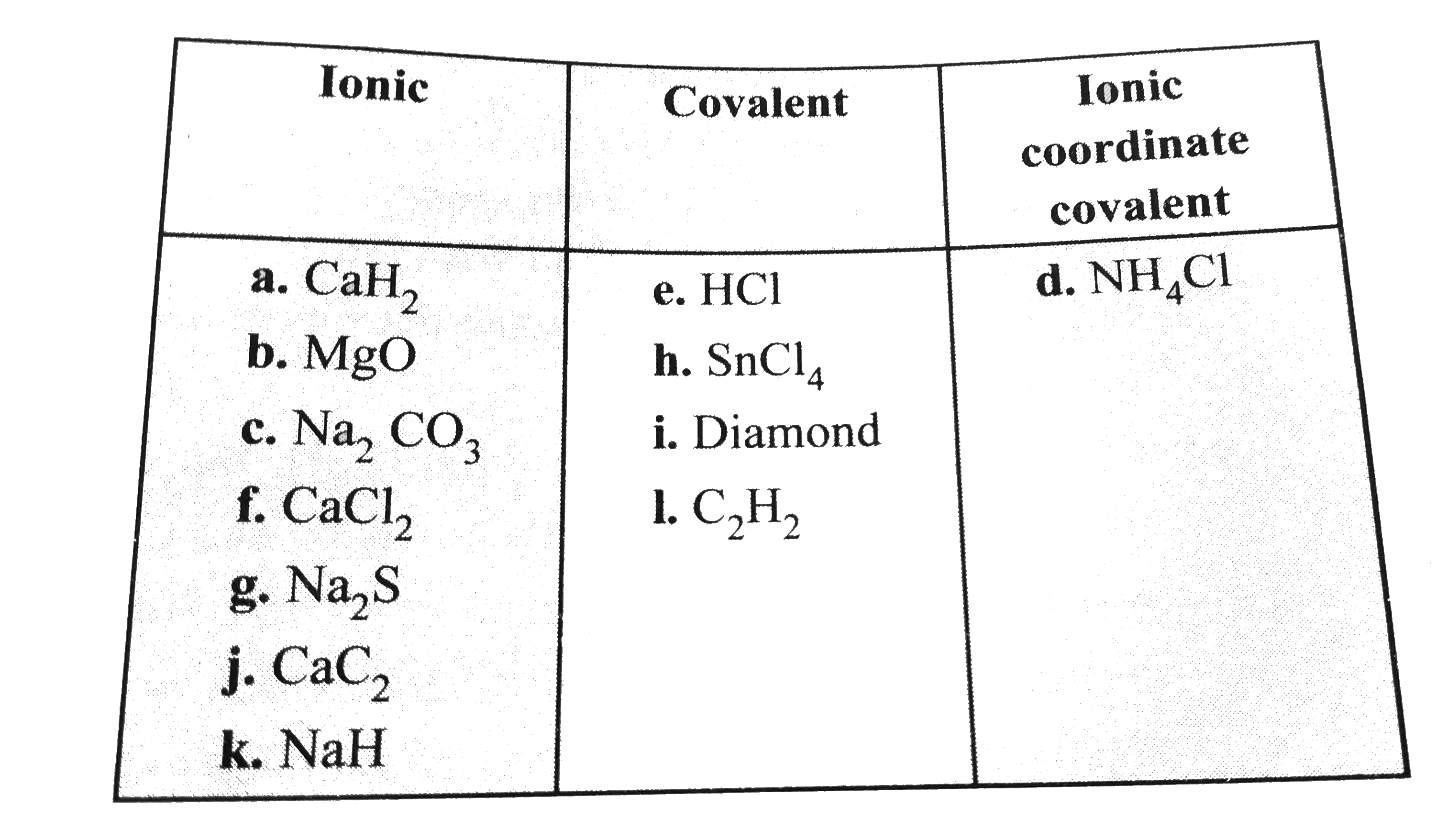State whether the following are ionic or covalent
(a) CaH2 (b) MgO (c ) Na2CO3 (d) NH4CI
(e) HCI (f) CaCI2 (g) Na2S(h) SnCI2
(i) Diamond (j) CaC2 (k) NaH (i) C2H2 .
 .
.
Topper's Solved these Questions
- CHEMICAL BONDING AND MOLECULAR STRUCTUREBook:CENGAGE CHEMISTRYChapter:CHEMICAL BONDING AND MOLECULAR STRUCTUREExercise:Ex 2 .2 Subjective (Molecular Orbital Theory)
Explore 4 Videos
- CHEMICAL BONDING AND MOLECULAR STRUCTUREBook:CENGAGE CHEMISTRYChapter:CHEMICAL BONDING AND MOLECULAR STRUCTUREExercise:Ex 2 .2 Objective
Explore 34 Videos
- CHEMICAL BONDING AND MOLECULAR STRUCTUREBook:CENGAGE CHEMISTRYChapter:CHEMICAL BONDING AND MOLECULAR STRUCTUREExercise:Solved Examples
Explore 36 Videos
- ATOMIC STRUCTUREBook:CENGAGE CHEMISTRYChapter:ATOMIC STRUCTUREExercise:Concept Applicationexercise(4.3)
Explore 19 Videos
- CHEMICAL EQUILIBRIUMBook:CENGAGE CHEMISTRYChapter:CHEMICAL EQUILIBRIUMExercise:Archives (Subjective)
Explore 11 Videos
Similar Questions
Knowledge Check
Which of the following salt/s of H3PO3 exists ?
(I)) NaH2PO3 (II) Na2HPO3 (III) Na3PO3AI and II onlyBI, II and IIICII and III onlyDIII onlyArrange the following equations in the correct sequence to obtain a normal salt.
(a) NaOH+Na2HPO4→Na3PO4+H2O
(b) NaOH+H3PO4→NaH2PO4+H2O
(c) NaOH+NaH2PO4→Na2HPO4+H2OA231B123C321D312
Classify the following into electrophilies and nucleophiles:
(a) H+ , (b) NH3
(c) AlCl3 , (d) NO+2
(e) CN− , (f) H2O
(g) ROH , (h) H2O
(i) Carbocation.
View Solutionwhich one of the following reaction is not associated with the solvay process of manufacture of Na2CO3? (A) NaCl+NH4HCO3→ NaHCO3+NH4Cl
(B) 2NaOH+CO2 → Na2CO3+H2O
(C) 2NaHCO3→ Na2CO3+H2O+CO2
(D) NH3+H2CO3 → NH4HCO3
View SolutionPredict the sign of ΔS (positive or negative) for the following changes :
(i) HCOOH(l)→H2O(l)+CO2(g)
(ii) NH3(g)+HCI(g)→NH4CI(s)
(iii)I2(s)→I2(g)
(iv) 2O3(g)→3O2(g)
(v) 2H2(g)+O2(g)→2H2O(l).
View SolutionDetemine the oxidation no. of the folliwing elements given in bold letters:
(a) KmnO4, (b) H2SO5
(c) H2S2O8m (d) NH4NO3
(e) K4Fe(CN)6, (f) OsO4
(g) HCN, (h) HNC
(i) HNO3, (j) KO2
(k) Fe3O4, (l) KI3
(m) N3H, (n) Fe(CO)5
(o) Fe0.94O, (p) NH2NH2
(q) FeSO.(4).(NH4)2SO46H2O
(r) Na2[Fe(CN)5NO], (u) [Fe(NO)(H2O)5]SO4
(v) Na2S4O6
(v) Na2S2O3
(w) Dimethyl sulphoxide or (CH3)2SO
(x) Na2S2O3, (y) CrO5 or CrO(O2)2
(z) CaOCl2
View SolutionCount the number of pairs which may act as a buffer solution when present in a given solution
(a) CH3COOH+NaOH (b)
(c) NH4CI+HNO3 (d) HCIO4+KCIO4
(e) H3PO4+NaOH (f) H3PO3+NaOH
(g) NaHCO3+Na2CO3 (h) H2SO4+Na2SO4
(i) CH3COONa+HCI
(j)
View SolutionWhich of the following pair of solutions does not form a buffer solution?
(A) NaH2PO4 and Na2HPO4
(B) H2CO3 and NaHCO3
(C) NH4OH and NH4Cl (D) KOH and K2SO4
View Solution

